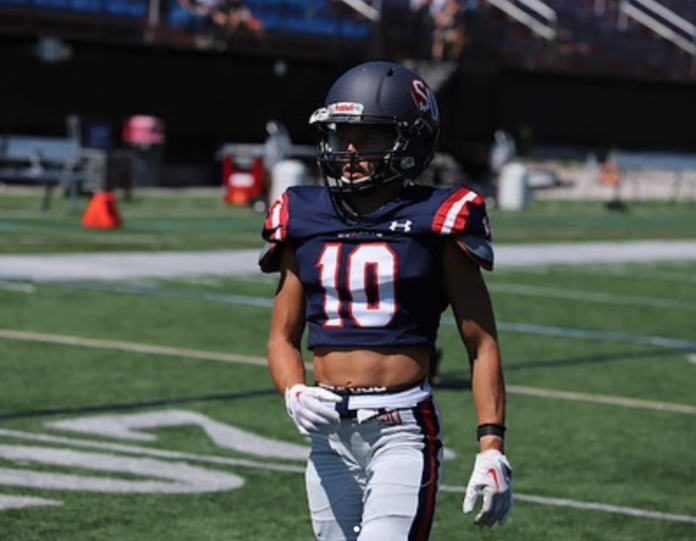
In late September, it was reported that a Shenandoah University student, Haley Van Voorhis became the first female non-kicker to play in a DIII NCAA football game. Van Voorhis plays on the team’s defense as a safety. This story broke through and was covered by national media outlets such as ESPN and CNN. Many lauded this first as a historical milestone for female athletes and women at large. It was later revealed that Van Voorhis was actually not the first woman to reach this accomplishment, despite the surge of media coverage. Two weeks prior to Van Voorhis’s first game, Taylor Crout played cornerback for Fitchburg State. Regardless of the semantics, both Crout and Van Voorhis’s participation in the traditionally male-dominated sport is historic to say the least.
Muhlenberg College’s football team has yet to include a female player. However, Head Football Coach Nate Milne relayed to The Weekly that this isn’t out of the realm of possibility for the team. Milne stated that, “certainly if there were females up for that (joining the football team), absolutely. That would be something we were intrigued with.”
Milne continued noting, “I don’t think our campus is a male-dominated culture campus…And so I think it would probably be easier than we think to have a female join our program. I think our players are respectful across campus, I think our players understand the importance of having females in important roles on our campus.”
When asked if he felt that a female athlete could bring something different to the team, Milne stated that “historically, male athletes aren’t willing to ask for help or share feelings and things like that. And maybe a female athlete would be more willing to say, ‘Hey, looks like Joe is having a bad day’ where Joe may not say something…But maybe she would pick up on it a little easier.”
While bringing female athletes into the realm of college football is a big win from the vantage point of representation, health and safety concerns arise. Assistant Professor of Public Health and author of “No Game for Boys to Play: The History of Youth Football and the Origins of a Public Health Crisis” Kathleen Bachynski, Ph.D., centers her research on sports-related brain injuries. When discussing the risks of tackle football, Bachynski expressed, “unfortunately, brain injuries are very significant risks of a collision sport. And not only do they have the short term risks, but we are also obviously, in the last decade or so, becoming far more aware in public conversation about the long term risks as well, specifically, repetitive or cumulative brain trauma.”
The risks associated with tackle football are not unfounded claims. According to New York University, “someone who plays four years of high school football can experience 6,000 to 7,200 subconcussive hits [and] playing four years of college football additionally doubles the amount of hits—12,000 to 14,400 hits to the head before a player has the opportunity to play in the NFL.”
In a study conducted by Boston University (BU), researchers examined the brains of 376 National Football League (NFL) players and diagnosed 91.7 percent of them with Chronic traumatic encephalopathy (CTE). This fatal brain injury is caused by continuous blows to the head and according to BU can result in “memory loss, confusion, impaired judgment, impulse control problems, aggression, depression, anxiety, suicidality, parkinsonism and, eventually, progressive dementia.”
So, the question arises: do we want to expose an entire other sect of athletes to the dangers that come along with playing tackle football?
In the past, women have been regulated to the position of kicker. Bachynski expands on this saying, “the reason you might have noticed the sort of highlight of like the non-kicker is that if girls or women are ever allowed on a team, it was almost always in the kicker role. And I might be sort of spelling out the obvious, but kicker is a lower risk position.”
Not only is the role of kicker a physically safer position, Bachynski describes it as “socially safer,” as well. Bachynski explains the meaning behind her statement saying, “I think there are more social perceptions of tackling being not as appropriate for girls or too dangerous for girls, or social anxieties about girls tapping boys or getting tackled by boys. And being a kicker doesn’t raise those same kinds of issues.”
College tackle football is a massive enterprise that roots itself in tradition and loyalty. On one hand, the introduction of women into this world can be viewed as a landmark achievement even if it is at the DIII level. Conversely, the sport is dangerous, with inherent risks involved in every play. There is a level of fear associated with potentially exposing more individuals to these risks. Whether Muhlenberg will follow its peer institutions and bring a female player into its ranks remains to be seen. Will Muhlenberg College have future female football players in its program? It should be interesting to see if this movement continues and how the public’s perception of potential female football players evolves.
Katie is a Media & Communication and Political Science double major in the class of 2024. When she's not working on the paper you can find her blasting Taylor Swift, reading Jane Austen, or crying over Little Women (2019).






















